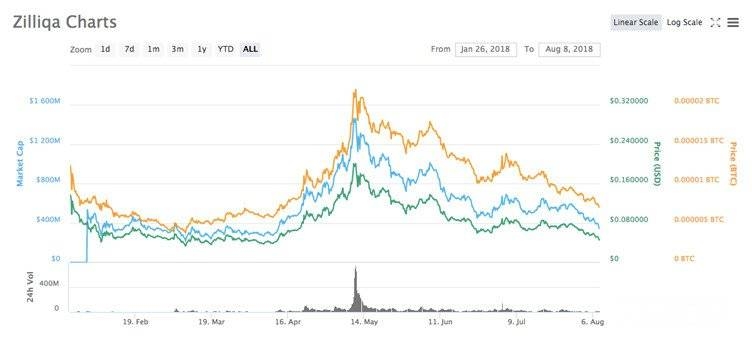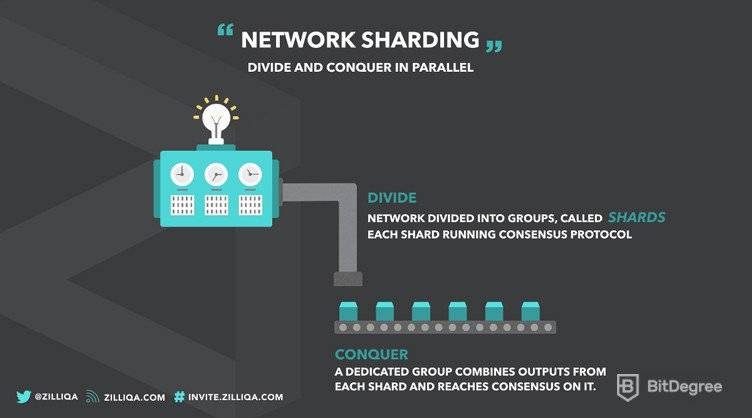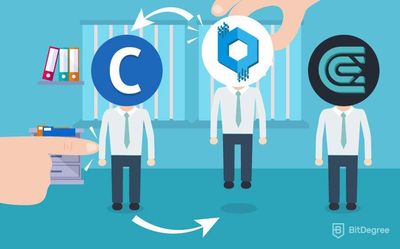Free Airdrop Season 7 is LIVE! Answer fun questions or do simple tasks to earn rewards from the $30K BitDegree prize pool. Participate Now ! 🔥
Greetings, crypto fans! Welcome to my beginner’s guide to Zilliqa ICO.
There are tonnes of new crypto coins coming on to the market all the time. With so many new coins, it can be hard to work out which ones are legit. If I want to know if a new coin is legit, I look at four main things.
They are:
- The team: Are the creator's tech superstars or hopeless newbies?
- The tech: Is the coin doing anything new and exciting or is it just a Bitcoin rip-off?
- The coin’s community: Does the coin have a lot of fans and a great development community?
- The coin’s real-world value: Is the coin useful? Does the world need it?
If a new cryptocurrency can answer “yes” to each of these questions, then it’s probably legit. So, can Zilliqa coin pass the test? And what does the Zilliqa ICO have to do with it? Let’s find out...
In this guide, I will be looking at Zilliqa’s team, its tech, its community, and its real-world value. By the time you finish reading, you’ll know everything worth knowing about one of the most exciting new cryptocurrencies of the year!
I’ll begin by looking at the basics, what is Zilliqa and where did it come from?

Did you know?
Subscribe - We publish new crypto explainer videos every week!
How Does Cryptocurrency Work? (Explained with Animation)


Table of Contents
What is Zilliqa?

Head to BitDegree Missions, gather as many Bits as possible & claim your stake of the $30,000 Prize Pool! Don't waste your time & start collecting Bits by completing Missions and referring friends.
Zilliqa was created in 2017 by a group of computer scientists and academics. The team is lead by Prateek Saxena from the University of California and Xinshu Dong and Amrit Kumar from the University of Singapore. Whilst the team doesn’t have a huge amount of experience in crypto, it does have the support of advisors from established networks like Kyber.
Its website describes Zilliqa as a “next-gen, high throughput blockchain platform.” But what does that mean? Put simply, Zilliqa is a faster, more advanced blockchain. Bitcoin was the first generation of cryptocurrency, platforms like Ethereum were the second and newer platforms like IOTA and Zilliqa, which are the third.
Third-generation platforms are trying to solve some of the problems that have affected older cryptocurrencies. The main problem Zilliqa is trying to solve is scalability.
Zilliqa hopes to solve the problem of scalability with a system called sharding which I will discuss in the next section. Zilliqa is the first platform to use sharding which caused a lot of excitement in the crypto community. The excitement leads to an unplanned Zilliqa ICO in 2017.
Zilliqa ICO
By the end of 2017, Zilliqa had secured 20 million US Dollars worth of private funding. This meant that they didn’t need to use an initial coin offering (ICO) to develop the platform.
However, the team decided to hold a Zilliqa ICO anyway because so many people wanted to be involved in the project. The Zilliqa ICO raised 22 million USD between December 27, 2017, and January 4, 2018.
At the time I’m writing this (06/13/18), the Zilliqa mainnet hasn’t yet been launched. This means that the platform is still being built and tested. Whilst this is happening, Zilliqa coin (ZIL) is based on the Ethereum blockchain. It follows the rules Ethereum has set out for new coins that are built on its network. Zilliqa coin is therefore known as an ERC-20 token. These ERC-20 tokens will be transferred to the Zilliqa blockchain when the Zilliqa mainnet goes live.
Before I look more closely at how Zilliqa works, I want to show you how well Zilliqa has performed in the market since the Zilliqa ICO.
Zilliqa Market Stats

Zilliqa Market Cap Chart | Source: coinmarketcap
In the last 24-hours, more than 50 million USD worth of Zilliqa coin has been bought and sold. Not bad for a platform that hasn’t even launched yet! The total value of all Zilliqa on the market now is over 630 million USD.
During the Zilliqa ICO, the price of each token was 0.0038 USD. Today, the price of each Zilliqa is about 0.085 USD. This means that the Zilliqa price is more than twenty times higher than it was at the time of the Zilliqa ICO, six months ago.
The total supply of Zilliqa is capped at 12.6 billion. More than 7.35 billion tokens are in circulation already. It’s possible that the price of Zilliqa could go up even higher when its total supply is in circulation and after its mainnet has gone live (this is not financial advice, it’s just a guess!). Zilliqa is the 27th biggest cryptocurrency on the market so it will be very interesting to see where the platform is ranked after its launch.
So, now you know what Zilliqa is. But what is Zilliqa going to do when it launches and how will it work? To answer these questions we need to look at Zilliqa’s technology…
How do Transactions Work?
To understand what’s so special about Zilliqa’s technology, you first need to understand the problems it’s trying to solve. Let’s take a quick look at how transactions work on a less advanced cryptocurrency network. I’ll use Bitcoin as an example.
Bitcoin transactions
Patty wants to send Selma 10 Bitcoin (BTC). Here’s how the transaction will work on the Bitcoin network;
- Patty broadcasts her transfer request to the Bitcoin network which is made up of thousands of computers called nodes.
Note: Nodes are computers that hold the whole Bitcoin blockchain and contribute computing power to verify transactions that are made. The blockchain is a database of every Bitcoin transaction that has ever been made.
- Patty’s request is encrypted and mixed with transaction information from other users by special nodes called miners. The information is grouped into a block.
Note: Encryption is a system for hiding information with computer code.
- Miners now race each other to guess the code number which is given to the completed block by the Bitcoin protocol.
- The block information is broadcast to all the nodes on the network. If more than half of the nodes agree that the block is valid, then it can be added to the blockchain.
- Selma receives 10 BTC from Patty.
This process happens for every Bitcoin transaction and it takes quite a long time. The average Bitcoin transaction time is about 10-15 minutes but it can take more than an hour. This is the scalability problem I mentioned earlier.
The Bitcoin network can only process around 3-7 transactions per second (Tx/s). Even Ethereum’s Tx/s is only 20-30. To put this into context, payment providers like Visa can process an average of 2000 Tx/s but can go as high as 24,000 Tx/s!
Networks like Bitcoin and Ethereum get slower as they get bigger! Remember, every node is involved in deciding whether or not a block is valid. The more nodes there are in the network, the longer it will take to reach a decision.
So, what is Zilliqa doing differently? The answer to this question is sharding...
What is Sharding?
Zilliqa ICO hopes to use sharding to solve the scalability problem. Sharding involves dividing the Zilliqa network into groups of nodes called shards. Each shard is made up of 600 nodes. Shards operate like mini-blockchain networks.
Shards process transactions separately from each other rather than as a group. This allows a lot more transactions to be processed. It also means that the network will process transactions faster as it grows. The more shards there are, the more transactions they can process.
Zilliqa processed 1,218 Tx/s using 3 shards (which is 1,800 nodes) on its private testnet in October 2017. Using 3,600 nodes or 6 shards, the Zilliqa testnet processed 2,488 Tx/s. Transaction speeds on Zilliqa’s public testnet are slightly less impressive. Testnet v1.0 has 961 nodes running on it and is producing a transaction time of just over 100 Tx/s. However, this is still more than ten times faster than Bitcoin!

So, sharding makes processing transactions a lot faster but the system does have its problems. Next, I’ll explain what those problems are and how Zilliqa deals with them.
Problems with Sharding
The main problem with sharding is that when you divide a blockchain into groups of nodes, you also divide the information stored on it. Remember that each Bitcoin node contains the whole blockchain. This means they don’t need any other information to process transactions.
Nodes in shards only contain some of the blockchains. This means that they need to communicate with other nodes to get all the information they need. This can get very complicated on a network of thousands of computers!
Think of it like this. Take a book and cut it in two. Give one half each to Patty and Selma. Now, Patty will only know the beginning of the story and Selma will only know the end. To find out the full story, Patty and Selma will have to talk to each other.
Sharing a whole blockchain is a bit like shedding a whole library, dropping the pages over Germany and asking the population to put it back together again! It would take a lot of energy and communication, wouldn’t it?
Zilliqa solves this problem with a hybrid consensus mechanism though. Don’t worry it’s more simple than it sounds!
Zilliqa Hybrid Consensus Mechanism
A consensus mechanism is a system used by a network to agree. Consensus means agreement and mechanism means system!

The Bitcoin consensus mechanism requires more than half of all its nodes to agree for a transaction to take place. Zilliqa uses two layers of consensus mechanisms to agree. This is what the word hybrid means. The layers are:
- Shard layer: Whole blocks of information aren’t processed at the shard level. Shards only process parts of blocks called micro-blocks. Nodes on the shard layer only need to access a small amount of information so they don’t need to communicate with other shards.
- DS layer: A small group of randomly-selected nodes forms a group called a DS-committee. The group then combines the macro-blocks into a whole block and reaches an agreement on whether it’s valid or not. These nodes have access to the entire blockchain so they can make a final decision on each block.
When a network reaches consensus using this mechanism there can’t be a disagreement between nodes leading to a fork. This is called finality and it helps the network to process transactions quickly and efficiently. Reaching consensus in this way also uses less computer power than the systems used by blockchains like Bitcoin and Ethereum.
Now you know that Zilliqa has some very special tech. But who’s going to use it and what will they use it for?
How Can Zilliqa be Used?
Ever since the Zilliqa ICO, the crypto community has been waiting to see if the Zilliqa network can deliver the services it’s offering. But who will get the most from using Zilliqa? Zilliqa is a public blockchain so anyone can use it. However, the platform will appeal mostly to users who want to develop high-volume smart contracts and dApps.
There is a gap in the market for a platform that can support smart contracts and dApps which require high-transaction speeds to run successfully. When the Zilliqa main net goes live, it could host a large social media dApp similar to Facebook or Twitter. It also has the potential to support advertising campaigns and payment processing services.
The platform has huge potential which the Zilliqa ICO proved. Transaction speed tests have made even more people excited and caught the attention of the development community. The Zilliqa blockchain could be very busy when it launches!
One of the main concerns users have about new platforms is safety. So, what is Zilliqa doing about security?
Is Zilliqa Secure?
Blockchains are very safe when compared with networks that use centralized data storage, like Google or Visa. A blockchain is made up of thousands of systems. To hack a blockchain, you need to control more than half of the nodes on it.
Zilliqa has two unique security features:
- Hybrid consensus mechanism (HCM): The first layer of Zilliqa’s HCM verifies the identity of nodes. This stops Sybil attacks from happening.
Note: A Sybil attack is where one hacker poses as lots of different nodes to gain control of a network or send invalid transactions.
The second layer of the HCM gives transaction finality so there can be no hard forks on the network.
- Scilla: Zilliqa has its coding language called Scilla. Scilla only allows developers to create software that will run safely on the Zilliqa network. Users can trust the smart contracts that are written using it.
Overall, Zilliqa is a safe platform but it’s important to remember that it’s still being developed. This means that there are some things that it can’t do safely yet. Improvements need to be made to stop the platform from being abused.
How Can it be Abused?
Zilliqa can only run the simplest parts of a smart contractor dApp at the moment. Running whole smart contracts would require a huge amount of communication between shards.
If Zilliqa tried to process whole smart contracts using sharding then contracts could be in different states on different shards. This could allow hackers to alter the blockchain. If the platform is going to reach its full potential then it will have to solve problems like this before it launches.
This is a challenge facing all cryptocurrencies. Platforms want to include as many features as possible without putting their network at risk of attack. Whether or not cryptocurrencies can scale safely will be very important for the whole market over the next few years.
So, what do you think about Zilliqa? Has it passed the test? Let’s find out…
Zilliqa: Pros and Cons
 PROs
PROs
✓ It has great new tech: Zilliqa is the first platform to use sharding technology. This puts it ahead of the rest of the market. It’s a completely new kind of blockchain designed to solve the problem of scalability. Third-generation platforms like Zilliqa could be the big winners in the future of cryptocurrency.
✓ It has a strong community: The platform has a lot of fans. The Zilliqa ICO only happened because there was so much demand for it. The Zilliqa ICO also shows that the crypto community is ready to see blockchain technology move to the next phase of its development.
 CONs
CONs
✗ It has an inexperienced team: The creators of Zilliqa are academics, not businessmen. Zilliqa’s tech is ahead of the rest of the market but its business isn’t. Other platforms - like OmiseGo - have much stronger links with real-world organizations. Zilliqa has some serious work to do if it wants to be among the biggest cryptocurrencies.
✗ It’s still being developed: The mainnet launch was supposed to be in the middle of 2018 but it now looks like it won’t be launched before September. It’s almost impossible to tell what kind of real-world value Zilliqa will have until it launches. Only then we will find out what kinds of smart contracts and dApps it can support and at what speeds. The longer that Zilliqa remains in development, the more chance there is that other platforms will catch up. For example, Ethereum is working on its scalability solution right now!
So there it is! My complete beginners guide to Zilliqa. I’ll leave you with a few last thoughts…
Final Thoughts
Zilliqa is an exciting new cryptocurrency and you now have a better understanding of it than most people. You know where it came from and what it can do. You also know about the Zilliqa ICO and the power of sharding.
2018 will be a big year for Zilliqa. The crypto community has heard a lot about what the platform can potentially do, but now we want to see the proof!
When the Zilliqa mainnet launches, all questions about scalability and transaction speeds will be answered. Will the excitement of the Zilliqa ICO be rewarded? Your guess is as good as mine. A lot could happen in crypto over the next few months!
The third generation of cryptocurrency is being led by platforms like Zilliqa and I can’t wait to see where they’ll take us!
How about you? Are you excited about Zilliqa? Or is there another third-gen blockchain project you think I should be writing about?
The content published on this website is not aimed to give any kind of financial, investment, trading, or any other form of advice. BitDegree.org does not endorse or suggest you to buy, sell or hold any kind of cryptocurrency. Before making financial investment decisions, do consult your financial advisor.


















